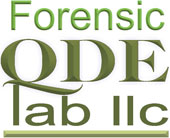1. Ask as many questions as you can.
If this is your first experience with a Forensic Document Examiner, it is likely you will have loads of questions. Most experts are glad to answer your questions to help you understand just what it is we do. It is also important to understand what we do not (or should not or cannot) do.
If, for instance, you have a signature on a document that you would like to have authenticated, but all you have is a copy – a poor one at that – your expert will probably not be able to provide you with a definitive identification of the author. That does not mean that a qualified opinion wouldn’t be possible. The point being, the results of an examination are often limited by the quality or quantity of the evidence being examined. Knowing this going in, you can avoid possible disappointment later.
2. Be very clear about your objective.
Once you have had a chance to consult with your Handwriting Expert, he or she will want to know exactly which documents are in question and why. Be clear in your mind which of the documents you present are actually genuine and known to you to be the authentic writing of the person of interest and which are the documents that contain writing that could be in question. Changing your mind in the middle of an examination can cost you valuable time and money. Discovering that you, the client, have not done your homework is disruptive to an examination, but definitely should not happen while the expert is testifying!
3. Prepare all of your evidence and deliver it at once if possible.
As you may have discovered, hiring an expert is a bit pricey. If you are looking for ways to keep costs down, I recommend that you gather all the documents you can find that are requested by your expert and deliver them in advance of the examination. Once the examination begins, the Document Examiner will be considering all of the evidence individually and as a body. Talk to your expert about this. If documents “dribble” in, your expert may want to wait until you have found everything you can.
Sometimes, he or she will determine that there is not enough information within the samples already delivered and request additional samples. When you think you have found everything there is to find, it may not have occurred to you to look in the old file cabinet in the garage or a forgotten box of mementos in the attic. Finding more documents may seem like a daunting task, but your expert knows what to look for to provide the most productive results possible. If more documents are requested, do your best to comply.
4. Allow the Document Examiner the time required to arrive at an opinion.
Usually your expert will let you know how much time is required to examine your case. The time required may be due to his or her schedule or to the complexity of your case. Find out what is necessary and try not to rush the expert. Though the actual billable time spent on your evidence seems small, the expert is usually working on more than one case at a time. In fact, some experts prefer to analyze the materials in stages or segments of time. This allows for the circumspection necessary for an accurate level of confidence in the opinion.
5. Understand the opinion and how it may affect your case.
You notice that the report says something like, “the K1 writer probably wrote the Q1 signature.” You are wondering why your expert couldn’t just say “Yea or Nay”. You’re thinking that you paid all that money for a “probably”?
For many attorneys, the term “probably” can be interpreted in court lingo to mean “more likely than not” which is the level of confidence required in civil trials. (A higher level of confidence is required for criminal court.)
Remember that your Handwriting Expert should be committed to providing an objective opinion based on an accurate evaluation of the evidence. Handwriting Experts must consider any shortcomings in the evidence provided and qualify their opinion based on the shortfall of evidence even though it may seem obvious to you that John Smith did not write his name on the document in question.
